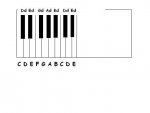You are using an out of date browser. It may not display this or other websites correctly.
You should upgrade or use an alternative browser.
You should upgrade or use an alternative browser.
To All Piano Players
- Thread starter Girlnezz
- Start date
Skysaw said:Between C and D. A flat lowers a note one half-step (next closest piano key downward), while a sharp raises it. So Db is one piano key lower than D.
This note is enharmonically equivalent to (sounds the same as) C#. If you look at the keys, you will see why this is so.
thank you so much
Skysaw said:To be precise, Db minor contains an Fb, not an E.
Looks the same on your keyboard, but not on paper.
Precise maybe, but confusing

Not confusing if you just remember that ALL diminished, minor, major, and augmented chords based on Db, D, or D# contain the letters D, F, and A. That's just the way tertian harmony works.
Db, Fb, Abb
Db, Fb, Ab
Db, F, Ab
Db, F, A
D, F, Ab
D, F, A
D, F#, A
D, F#, A#
D#, F#, A
D#, F#, A#
D#, F##, A#
D#, F##, A##
Db, Fb, Abb
Db, Fb, Ab
Db, F, Ab
Db, F, A
D, F, Ab
D, F, A
D, F#, A
D, F#, A#
D#, F#, A
D#, F#, A#
D#, F##, A#
D#, F##, A##
Isn't there some funky 'x' type symbol for ##? It's been awhile since I've seen one. I took classical piano from when I was ~9 until I was about 17, but quit because I sucked at playing classical music. But I did get pretty good at music theory and coming up with piano parts for folky music.
Skysaw said:Not confusing if you just remember that ALL diminished, minor, major, and augmented chords based on Db, D, or D# contain the letters D, F, and A. That's just the way tertian harmony works.
Db, Fb, Abb
Db, Fb, Ab
Db, F, Ab
Db, F, A
D, F, Ab
D, F, A
D, F#, A
D, F#, A#
D#, F#, A
D#, F#, A#
D#, F##, A#
D#, F##, A##
Yes, a double-sharp has a x-like symbol, usually a little squat looking, with tiny squares on the tips of the lines. There is another version of the symbol which has dots between the lines, but I've always hated that one, so I don't remember exactly what it looks like.
I figured ## would be more understandable than x on the forum.
I figured ## would be more understandable than x on the forum.
wow...
this group never ceases to amaze me. From mixing tutorials to music theory instruction...can someone tell me what I am paying 40 dollars a month for 30 minute piano lessons that teach...well...nothing?!
Anyhow, has anyone ever entertained having a branch of the forum dedicated to theory. I know this may be a bit farfetched but I have run into many members here who seem to have a knack for theory in lamens terms. And a lot of the newbs need some theory musically to truly understand mixing and what not just sounds good to the ear but is truly proper for recording purposes.
-Humble-
this group never ceases to amaze me. From mixing tutorials to music theory instruction...can someone tell me what I am paying 40 dollars a month for 30 minute piano lessons that teach...well...nothing?!
Anyhow, has anyone ever entertained having a branch of the forum dedicated to theory. I know this may be a bit farfetched but I have run into many members here who seem to have a knack for theory in lamens terms. And a lot of the newbs need some theory musically to truly understand mixing and what not just sounds good to the ear but is truly proper for recording purposes.
-Humble-
TexRoadkill
Audio Bum
The only places where there is no black key between the whites is between B-C and E-F. There are two black keys close together then 3 black keys close together. The first of the two close together is the D flat.
ausrock
Well-known member
All the notes within one octave are;
A, Bd (Flat), B, C, Dd, D, Ed, E, F, Gd, G, Ad
OR
A, A#(Sharp), B, C, C#, D, D#, E, F, F#, G, G#
Note that B doesn't have a sharp and C doesn't have a flat, and E & F are similar to B & C in that regard. In other words, the white B and C keys are together, and similarly for E and F.

A, Bd (Flat), B, C, Dd, D, Ed, E, F, Gd, G, Ad
OR
A, A#(Sharp), B, C, C#, D, D#, E, F, F#, G, G#
Note that B doesn't have a sharp and C doesn't have a flat, and E & F are similar to B & C in that regard. In other words, the white B and C keys are together, and similarly for E and F.

ausrock said:If this works, please forgive the rough drawing.

aawww...thank you sooo much
James Argo
Fancy Rock N' Roll
To be precise, Db minor contains an Fb, not an E.
It's also confusing me at the first time. And my brother (he's violin teacher) kept telling me the same thing. C# is NOT the same as Db. And he showed me how to play that in violin...
 I din't get it tought
I din't get it tought 
Badger
Active member
ausrock said:If this works, please forgive the rough drawing.

Wait...None of my boards have those black keys.....No wonder I always play in a minor

